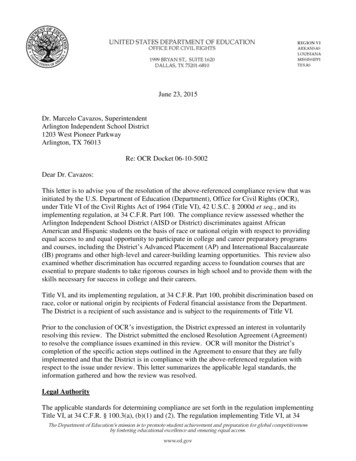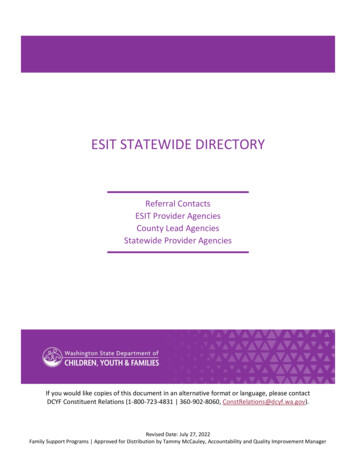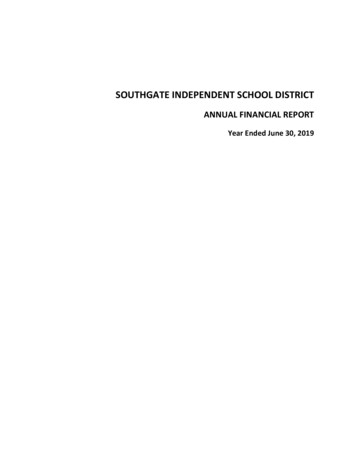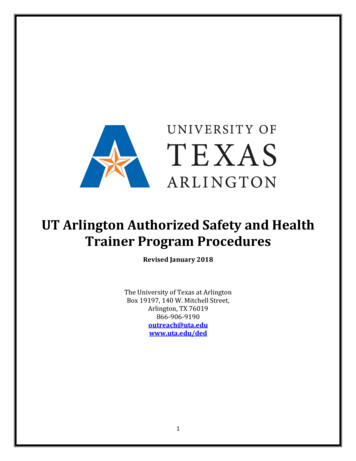
Transcription
June 23, 2015Dr. Marcelo Cavazos, SuperintendentArlington Independent School District1203 West Pioneer ParkwayArlington, TX 76013Re: OCR Docket 06-10-5002Dear Dr. Cavazos:This letter is to advise you of the resolution of the above-referenced compliance review that wasinitiated by the U.S. Department of Education (Department), Office for Civil Rights (OCR),under Title VI of the Civil Rights Act of 1964 (Title VI), 42 U.S.C. § 2000d et seq., and itsimplementing regulation, at 34 C.F.R. Part 100. The compliance review assessed whether theArlington Independent School District (AISD or District) discriminates against AfricanAmerican and Hispanic students on the basis of race or national origin with respect to providingequal access to and equal opportunity to participate in college and career preparatory programsand courses, including the District’s Advanced Placement (AP) and International Baccalaureate(IB) programs and other high-level and career-building learning opportunities. This review alsoexamined whether discrimination has occurred regarding access to foundation courses that areessential to prepare students to take rigorous courses in high school and to provide them with theskills necessary for success in college and their careers.Title VI, and its implementing regulation, at 34 C.F.R. Part 100, prohibit discrimination based onrace, color or national origin by recipients of Federal financial assistance from the Department.The District is a recipient of such assistance and is subject to the requirements of Title VI.Prior to the conclusion of OCR’s investigation, the District expressed an interest in voluntarilyresolving this review. The District submitted the enclosed Resolution Agreement (Agreement)to resolve the compliance issues examined in this review. OCR will monitor the District’scompletion of the specific action steps outlined in the Agreement to ensure that they are fullyimplemented and that the District is in compliance with the above-referenced regulation withrespect to the issue under review. This letter summarizes the applicable legal standards, theinformation gathered and how the review was resolved.Legal AuthorityThe applicable standards for determining compliance are set forth in the regulation implementingTitle VI, at 34 C.F.R. § 100.3(a), (b)(1) and (2). The regulation implementing Title VI, at 34
Page 2 – Dr. Marcelo Cavazos, Superintendent (06-10-5002)C.F.R. § 100.3(a), provides that no person shall, on the ground of race, color, or national origin,be excluded from participation in, be denied the benefits of, or be otherwise subjected todiscrimination under any program operated by a recipient. The regulation implementing Title VI,at 34 C.F.R. § 100.3(b)(1), prohibits a recipient, on the ground of race, color, or national origin,from denying an individual a service or benefit of a program; providing a service or benefit thatis different or provided in a different manner; subjecting an individual to segregation or separatetreatment in any matter related to the receipt of a service or benefit; restricting an individual inthe enjoyment of any service or benefit; treating an individual differently in determining whetherthe individual satisfies any admission, enrollment, eligibility or other requirement or conditionfor provision of a service or benefit; and, denying an individual an opportunity to participatethrough the provision of services or otherwise or affording an opportunity to do so which isdifferent from that afforded to others. The regulation implementing Title VI, at 34 C.F.R.§ 100.3(b)(2), prohibits a recipient from utilizing criteria or methods of administration that havethe effect of subjecting individuals to discrimination because of their race, color, or nationalorigin.The administration of how students participate in educational programs and classes can result inunlawful discrimination based on race and/or national origin if students are subjected to differenttreatment based on their race or national origin, or if a policy or practice that is neutral on its faceand administered neutrally results in a disproportionate and unjustified impact on students of aparticular race or national origin.Summary of ReviewDuring the investigation, OCR requested and received information from the District regarding itsstudent enrollment, curricula and class enrollment policies and procedures. The Districtsubmitted data to OCR concerning the enrollment of students in its college and careerpreparatory programs and classes for the 2013-2014 and 2012-2013 school years. OCRconducted two onsite visits and interviewed students, teachers, counselors and other staff. OCRalso examined the data provided by the District to the Department for the Civil Rights DataCollection (CRDC)1 and documents on the District’s website.Overview of the DistrictThe Arlington Independent School District is a school district in Arlington, Texas, a largesuburban city within the Dallas-Fort Worth metropolitan area. The District is the ninth-largestschool district in Texas, serving approximately 64,000 students. The District is comprised of 52elementary schools (Kindergarten through Grade 6), thirteen junior high schools (Grades 7through 8) and ten high schools (Grades 9 through 12). Twelve of the junior high schools aretraditional junior high schools and one is an alternative school.2 Six of the high school campuses(Arlington, Bowie, Lamar, Martin, Sam Houston and Seguin) are traditional high schools.3 In2014-2015, the District opened Arlington Collegiate High School at Tarrant County College(TCC) Southeast Campus; the school provides students the opportunity to earn a high school123http://ocrdata.ed.gov.Hereafter, references to “junior high school” will refer only to the twelve traditional junior high schools.Hereafter, references to “high school” will refer only to the six traditional high schools.
Page 3 – Dr. Marcelo Cavazos, Superintendent (06-10-5002)diploma and an associate degree in four years. The District has three special purpose highschools (Newcomer Center - for non-English speakers; Turning Point High School - analternative campus; and Venture High School – school focuses on dropout prevention and creditrecovery).According to data from the District’s website, during the 2013-2014 and 2012-2013 schoolyears, the District enrolled 63,873 and 64,381 students, respectively. For the 2013-2014 schoolyear, 15,582 (24%) students in the District were African American and 27,410 (43%) of thosestudents were Hispanic. For the 2012-2013 school year, 15,272 (24%) students in the Districtwere African American and 27,530 (43%) of those students were Hispanic.4The high school enrollment data by race/ethnicity for the 2013-2014 school year follow:2013-2014 High School Enrollment Data at Selected Campuses, by 0(7%)156(5%)184(11%)1,251(0%)Two HawaiianAmericanIndian36(0%)70(0%)High School Graduation RequirementsTexas state law high school graduation requirements changed during the course of this review.When the review was initiated in 2010, consistent with State law requirements, the Districtoffered three graduation program options. All students were required to select high schoolcourses necessary to complete the “Recommended High School Program” or “DistinguishedAchievement High School Program,” unless the student, the student’s parent or legal guardian,and a high school counselor or school administrator agreed that the student should be permittedto take courses under the “Minimum High School Program.” The “Recommended High SchoolProgram” required four courses in Math, English, Science and Social Studies (“4X4”) and the“Distinguished Achievement High School Program” required an additional language coursebeyond that required for the “Recommended High School Program.” Provided below is asummary of the requirements for each of the former diploma 113.pdf (2012-2-13 school year);http://aisd.net/pdf/GradeTally/eth060214.pdf (2013-2014 school year). School specific data on the enrollment ofAmerican Indian and Hawaiian students is not included on the chart because of the low numbers of these students ateach school.
Page 4 – Dr. Marcelo Cavazos, Superintendent (06-10-5002)Former High School Graduation Requirements and Diploma OptionsCurriculum AreaCredits RequiredMinimum HighRecommendedDistinguishedSchool ProgramHigh SchoolAchievement HighProgramSchool .0Social Studies4.04.04.0Health0.50.50.5Physical Education1.51.51.5Technology Applications1.01.01.0Communication Applications0.50.50.5Fine Arts1.01.01.0Languages (other than English)0.02.03.0Electives (State approved list)5.53.52.5Total24.026.026.0In 2013, the State revised the State's curriculum and graduation requirements.5 The“Recommended High School Program” was replaced with a 22-credit “Foundation High SchoolProgram” that allows students to earn “Endorsements” in specific areas of study by completingfour additional credits. The Endorsements include science, technology, engineering and science(STEM); business & industry; public service; arts and humanities; and multidisciplinary studies.For the “Distinguished Level of Achievement High School Program,” a student must completethe “Foundation High School Program,” an Endorsement course, Algebra II, and a fourthScience course. The “Foundation High School Program” became the default State graduationprogram for all students entering ninth grade beginning with the 2014-2015 school year.The District now offers the following three graduation program options:Current High School Graduation Requirements and Diploma OptionsCurriculum AreaCredits RequiredFoundation HighFoundation HighDistinguished LevelSchool ProgramSchool Program with of Achievement HighEndorsementsSchool ProgramEnglish4.04.04.0Math3.04.04.0(Algebra II required)Science3.04.04.0Social Studies3.03.03.0Physical Education1.01.01.0Foreign aspx (state website with information about high school graduation requirements).
Page 5 – Dr. Marcelo Cavazos, Superintendent (06-10-5002)Fine ginning with the 2014-2015 school year, State law required that school counsellors at theelementary, middle and high school levels advise students and their parents or legal guardians onthe importance of college, coursework designed to prepare student for college and financial aidavailability and requirements. Information about the “Distinguished Level of Achievement”must be published on each district’s website and made available to high school students.The District has published this information on its website and it is available to all students andparents.6 In addition to providing the information required under the new State law, the Districtrequires a District counselor or school administrator to review the personal graduation planoptions for each student entering ninth grade together with that student and his or her parent orlegal guardian. Before the conclusion of the ninth grade school year, the student and the student’sparent or guardian must confirm and sign a personal graduation plan for the student. Students arepermitted to graduate under the “Foundation High School Program” without earning anEndorsement if, after the student’s sophomore year, the student and the student’s parent or legalguardian are notified of the benefits of graduating with an Endorsement and the student’s parentor legal guardian gives written permission for the student to opt out of an Endorsement. Eighthgrade students are automatically scheduled into the “Career, Technical and Higher EducationInvestigations” class that explains the new graduation programs in detail.Advanced Academics ProgramThe District serves students through a variety of services and programs as part of its advancedacademics program, including its Gifted and Talented Services (G/T), as well as AP, IB, andDual Credit classes and/or programs.7Elementary SchoolThe District informed OCR that it offers G/T services at all of its elementary schools. Accordingto the District, these services include “an array of learning opportunities, including working withage peers, intellectual peers and working independently, during the school day and through cocurricular or extracurricular activities.” The District screens students beginning as early asKindergarten to determine whether they meet a minimum of three (3) criteria to be consideredfor the District’s G/T services. The District provides information about its GT services on itswebsite and states that the criteria considered for identification and placement are: 67Teacher observation checklistsEvaluation of student products (Student Portfolio)Student /LinkClick.aspx?fileticket ibmCxkbLXbA%3D&tabid 15047&mid 54578.http://www.aisd.net/AISD/Default.aspx?alias www.aisd.net/aisd/advacademics.
Page 6 – Dr. Marcelo Cavazos, Superintendent (06-10-5002) Structured analytical observationsStandardized assessments8Junior High SchoolThe District has, dependent on student interest and abilities, offered AP Spanish to students atthree junior high campuses (Carter, Hutchison, and Workman). These junior high schools feedinto Sam Houston High School, which is the only high school with a majority Hispanic studentenrollment. In the 2013-2014 school year, Sam Houston had a 65% enrollment rate for Hispanicstudents (compared to the 37% Districtwide enrollment rate for Hispanic high school students).The District also offers Pre-Advanced Placement (Pre-AP) courses in all twelve junior highschools. These courses include: English, Reading, English Language Arts/Reading, Math,Algebra, Science, Science II, Texas History/Geography, United States History/Citizenship, andSpanish Language. The District indicated that for student enrollment in Pre-AP courses, itconsiders factors such as the student’s past performance, accumulated test records, studentinterest, and parent approval.OCR also reviewed whether there were any differences in the availability of prerequisite orfoundation courses at the junior high level that would impact students’ preparedness for takingadvantage of college and career preparatory courses at the high school level. OCR determinedthat the twelve junior high schools in the District offer identical courses with the exceptionsnoted above for AP Spanish, which is offered at three junior high schools.The District publicizes information about Pre-AP, AP courses, the IB program, and dual credit tostudents and parents in several ways. Interested parents and students receive a Pre-AP and APExpectations of Enrollment letter from the District, explaining the rigor and standards of Pre-APand AP classes prior to enrollment in the class.9 The letter must be signed by the student and aparent and returned to the student’s counselor prior to enrollment in the course(s). According tothe District, parents are also notified via parent nights, the District's website and Parent-TeacherAssociation (PTA) newsletters. The District’s High School Course Description Handbook(Handbook),10 which is printed and available online in English, Spanish and Vietnamese,describes the benefits of AP courses and the dual credit options. The District provides brochuresfrom College Board along with informational pamphlets, created by the District, discussing APcourses and the IB program. Information about AP courses, IB program, and dual creditprograms is also available on the District’s website. Recruitment for high school AP courses andthe IB program begins in the junior high schools with high school counselors visiting with 8thgrade students and discussing different graduation options at the high school level. There is alsoan open house specifically for parents of 8th graders (Future Fish Night) where parents learnabout Pre-AP/AP, IB and dual credit courses. At the four campuses where the IB program isoffered, an IB program packet is available for students and parents. The IB program packet SCDHandbook/HSCDHandbook.pdf.“Honors” level courses are Pre-AP, AP and IBcourses.
Page 7 – Dr. Marcelo Cavazos, Superintendent (06-10-5002)available to students and parents in both English and Spanish. All of the high school campuseshave a fall and spring open house where information about AP courses and the IB program isdisseminated to attendees. The IB coordinators informed OCR that they also speak to the 9thand 10th grade students at their respective schools about the IB program.High SchoolAll six District high schools offer AP and Dual Credit courses. Four of the District’s high schoolcampuses (Arlington, Bowie, Lamar, and Sam Houston) offer the IB program. Early in OCR’sinvestigation, the District indicated that it planned to offer the IB program at the two remaininghigh schools (Martin and Seguin) in the future, but to date the District still does not offer the IBprogram at these two schools. Students have to attend a particular campus with IB to be enrolledin IB program. A student can transfer to a campus that has IB if they want to enroll in the IBprogram; however, transportation is not provided by the District to the new campus.The District uses a weighted system to calculate a student’s high school grade point average(GPA). Passing grades received in all “Honors” level courses receive three more points thangrades received in “regular” level courses.11 Grades received in dual credit courses are given bythe college instructors and do not count in the high school class rank or GPA calculations.12Pursuant to Texas law, students graduating in the top 10% of their high school class areguaranteed admission to any State-funded university. Under the current state law, Texasstudents entering ninth grade in the 2014 -2015 school year and thereafter must graduate underthe “Distinguished Level of Achievement High School Program” diploma to qualify for top 10%admission to Texas higher education institutions.13 Advanced PlacementCurrently, the District offers more than 28 AP courses at its high schools. The Districtdetermines the specific number of AP courses that will be offered at a specific high school basedon student interest. Thus, OCR’s investigation revealed that the number of AP course offeringsat each high school fluctuates from year to year depending on student interest.The District’s Handbook indicates that AP course offerings include, but are not limited to: APCalculus, Statistics, English, Biology, Chemistry, Physics, European History, HumanGeography, Macroeconomics, Psychology, United States Government and Politics, ComparativeGovernment and Politics, United States History, World History, Computer Science, MusicTheory, Studio Art, and foreign languages. The first opportunity to take AP courses in highschool is in 10th grade, with the World History AP course, although, as noted, AP Spanish isoffered to students at three junior high campuses.OCR’s investigation revealed that in a few situations each year, student enrollment for lesspopular AP courses falls below a point where would be economically feasible for the District toassign a teacher to a separate AP course. On this occasion, these students are still instructed byqualified teachers in classes of non-AP students. For example, a single student who wishes to11“Honors” level courses are Pre-AP, AP and IB spx?fileticket ibmCxkbLXbA%3D&tabid 15047&mid 54578.12
Page 8 – Dr. Marcelo Cavazos, Superintendent (06-10-5002)study AP Latin, may be physically assigned to a Latin III class, but receive instruction andassignments suitable for AP Latin.OCR examined the availability of AP courses for students at each high school. OCR found thatthe District high schools offered substantially similar curricula, with each of the high schoolsoffering between 13 and 25 AP course selections. During OCR’s review, Martin typically hadthe highest AP student enrollment and offered the highest number of AP courses. Sam Houstongenerally had the lowest number of AP course offerings, but it also offered students theopportunity to enroll in an IB program, which Martin does not offer. As noted above, SamHouston had a majority Hispanic student enrollment in the 2013-2014 school year. None of thehigh schools had a majority African American student enrollment. Martin had a majority whitestudent enrollment with a 60% enrollment rate for white students (compared to the 28%Districtwide enrollment rate for white high school students).With respect to enrollment in AP courses, the District states in its Handbook that studentsconsidering enrollment in AP courses should use the following criteria: Indication of high interest;Parent approval;Teacher recommendation;Satisfactory grades in prerequisite courses; andStandardized test scores that support the student’s grades and interest.Parents of students who wish to enroll in one or more AP courses and the students must sign thePre-AP and AP Expectations of Enrollment form prior to any student enrollment in the class(es).According to the District, in an effort to provide every student with the tools necessary tosucceed after high school, the District has implemented an “open enrollment” policy andpractice, under which any student desiring to enroll in AP courses can do so. However, OCRfound that the above enrollment and eligibility criteria continue to be listed in printed Districtcourse registration and handbooks as well as in published materials on the District’s website. TheDistrict explained that the listed prerequisites are not strictly required, although District staffmembers inform students of the subject matter that the student should have covered beforeenrollment in order to be academically successful in the AP courses.The District does not require payment for any AP courses offered at any of the high schoolcampuses. There are AP exam fees but students may also qualify for a fee reduction on an APexam. The District informed OCR that in the event a student is unable to pay the reduced examfee, the District will pay the fee.In interviews with OCR, District students cited the following as reasons they choose not to enrollin AP courses: not having taken the prerequisite courses and the need to make course selectiondecisions in junior high in order to take many of the AP courses. For example, a studentinterested in taking AP Calculus his/her senior year would generally need to have taken pre-APAlgebra 1 in eighth grade (junior high), pre-AP Geometry in ninth grade, pre-AP Algebra II intenth grade, and pre-AP Precalculus in eleventh grade. Students also cited the AP exam and thepotential of not receiving a passing score for which college credit would be awarded as a reasonwhy many choose not take AP courses.
Page 9 – Dr. Marcelo Cavazos, Superintendent (06-10-5002) International Baccalaureate ProgramThe IB program is a rigorous two-year program that begins in eleventh grade. Students whocomplete the program earn an IB diploma, which is considered a “Distinguished Level ofAchievement High School Program” diploma under the District’s three high school diplomaoptions. Over the course of the two-year program, students study six subjects, chosen from eachof six subject groups (language and literature, language acquisition, individuals and societies,sciences, mathematics, and arts), complete an extended essay, take a Theory of Knowledgecourse, and participate in a “Creativity, Action and Service” program. The IB program alsorequires the completion of an Extended Essay of approximately 4000 words. Many colleges anduniversities award course credit to students earning acceptable scores on IBexams. Additionally, in Texas, State institutions of higher education must grant at least 24semester credit hours to entering freshmen students who successfully complete the IB program,with a score of four or better on all exams.Students have to complete the IB application process in tenth grade. There is no GPArequirement, but interested students must have completed prerequisite courses during ninth andtenth grade prior to enrolling in the IB program. Specifically, a student must take French I/II orSpanish I/II in the ninth grade and if the student has not taken Algebra I in the eighth grade, thestudent must take Algebra I in the 9th grade and either take Geometry in the summer after ninthgrade or Geometry and Algebra in the tenth grade. If a student lacks an academic prerequisite,the District allows the student to take the academic prerequisites over the summer. Also, theDistrict recommends that students complete graduation requirements such as health, physicaleducation and speech in their ninth and tenth grade years. An IB student does not incur any costto take an IB exam at any of the high school campuses.When OCR interviewed high school students about the IB program, many had no knowledge ofthe program, even at the four schools that offer it. Some students and District teachers andcounselors identified concerns regarding prerequisites as a potential barrier for enrollment in theIB program. Similar to the concern with AP prerequisites, some students noted that they wouldgenerally need to have taken Algebra 1 in eighth grade or they would need to take summerschool or “double block” enrollment in Geometry and Algebra in the tenth grade. Dual Credit CoursesAll of the District high schools allow students to enroll in dual credit courses in lieu of and inaddition to AP courses and the IB program. Under the dual credit program, students earn collegecredit at the same time that they earn high school credit, although the grades earned for dualcredit courses are not included in the calculation of class rank or counted towards the GPA.Tarrant County College (TCC) provides instruction at college centers located on each highschool campus.14 Available dual credit courses include: U.S. History, Economics, English IV,Government, Psychology and Sociology. The District covers tuition costs and books for studentswho take advantage of dual credit offerings.14Some technical courses meet at TCC due to equipment availability, such as in HVAC, car repair, culinary andother specialized classes. See, http://www.aisd.net/News Articles/Headline News.aspx?Article ID 1255.
Page 10 – Dr. Marcelo Cavazos, Superintendent (06-10-5002)To qualify to enroll in dual credit courses, a student must have an 80 or above overall average inall courses or a 3.0 GPA and at least 16 credits. A student interested in dual credit courses mustpass the reading and/or writing portion of the Accuplacer or Texas Higher Education Assessment(THEA) test prior to registration.15In 2012, the District partnered with the University of Texas at Arlington (UTA) and TCC tostreamline high school students’ path toward affordable, accelerated college degrees. Theinitiative encourages high school students who complete 24 semester credit hours of dual creditcollege courses in their junior and senior years to advance to TCC to earn their associate degree.The high school college-credit courses allow students to earn high school and college creditsimultaneously, with the potential to earn up to a year of college credit toward theirundergraduate degree. UTA and TCC admissions and academic advising staff work withstudents to ensure that they take courses accepted toward their bachelor’s degree. Highperforming transfer students are eligible for a UTA scholarship of up to 10,000.16In interviews with OCR, students cited the economic and practical advantages of enrolling indual credit courses and receiving college credit. Some reported, however, that they preferred totake courses from District teachers, and not community college instructors. Many students alsoexplained that a complicated grade calculation may affect their enrollment decisions, as dualcredit courses are not counted in their high school GPA, which could positively or negativelyimpact a student’s class ranking, and thereby, affect a student’s eligibility for automatic collegeadmission under the State top 10% law and other college admission decisions.Enrollment DataGifted and Talented ServicesDuring the 2013-2014 school year, there were a total of 984 elementary school students enrolledin G/T services. African American students represented 24% of the students enrolled in gradesKindergarten through 6th grade District-wide, but only 10% (99) of the students enrolled in G/T.Hispanic students represented 46% of the students enrolled in these grades, but only 35% (339)of the students enrolled in G/T. While white students represented 21% of the students enrolled atthe elementary level, they accounted for 40% (398) of G/T students. OCR determined that bothAfrican American and Hispanic students were underrepresented to a statistically significantdegree with respect to enrollment in the District’s G/T services in the 2013-2014 school year.The data for the 2012-2013 school similarly revealed that African American and Hispanicstudents were underrepresented to a statistically significant degree with respect to enrollment inthe District’s G/T services in that school year.AP and IB Enrollment15The Accuplacer test is used by some educational institutions to assist in determining if a student is
High School Graduation Requirements Texas state law high school graduation requirements changed during the course of this review. When the review was initiated in 2010, consistent with State law requirements, the District . and a high school counselor or school administrator agreed that the student should be permitted











